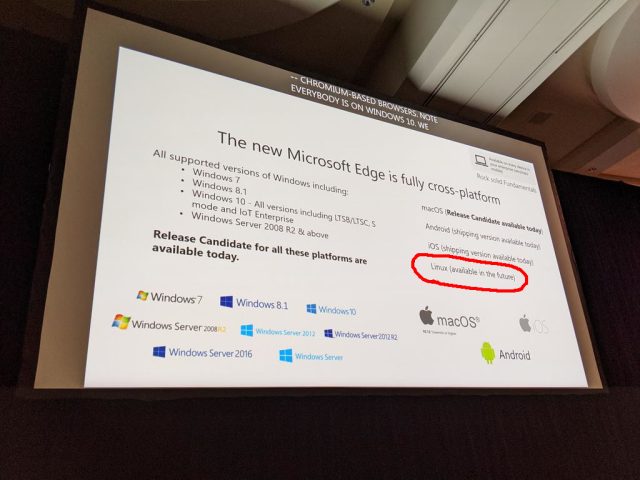At Microsoft Ignite last week, a slide announced that Microsoft's project to rebase its perennially unloved Edge browser on Google's open source project Chromium is well underway. Release candidates for the new Chromium-based Edge build are available on consumer and server versions of Windows (including Windows 7 and Server 2008, which have already left mainstream support), as well as MacOS, Android, and iOS.
Sharper-eyed attendees also noticed a promise for future Linux support.

Curious folks can download canary or beta versions of the new Edge for most operating systems from Microsoft Edge Insider—although there's nothing there yet for Linux. Browsing the Edge Insider site from Chrome on Linux replaces the download button with "Not supported for Linux." Using Firefox instead presents you with a download button for the Windows 10 version, presumably due to that browser's newly enhanced privacy controls.
We downloaded the Edge beta on a Windows Server 2012 R2 VM and took it for a quick spin. So far, it looks very much like Chrome itself—enough so that you might not notice which browser you're using unless you look very specifically.
-
Chrome and the new Edge Beta are both running here on Server 2012. Yes, you can tell which one is which... but you really have to work at it.Jim Salter
-
Part of new Edge's setup process is choosing a tab view—which sounds confusing, until you realize it just means what's on new tab pages. "Inspirational" tabs means "new tabs with neat wallpaper," basically.Jim Salter
-
"Informational" tabs means "yes, please, to all the marketing on new tabs" if you're as cynical as we are.Jim Salter
-
"Focused" tabs gets you something akin to Google Chrome's default new tab view—light on the frou-frou backgrounds and helpful links to media sites alike.Jim Salter
-
The Chromium-derived Edge immediately offered to suck up data from other browsers, including Google Chrome. Microsoft didn't even need to write any code for that; the functionality is already in Chromium.Jim Salter
For the moment, it doesn't look like there's much to get excited about in Edge's new Chromium flavor—it's pretty much just Chromium with one additional button that lets you go to your Favorites and another smiley-face button that sends feedback to developers. Browsing to chrome://extensions redirects you to edge://extensions and presents you with an offer to head to the Microsoft Store to find some. The profile button, similarly, takes you to a Microsoft login page rather than a Google one.
It seems unlikely that the Linux world is going to go ga-ga for what seems to essentially be a reskinning of Chromium—but that might be missing Microsoft's real thrust here. Many developers—including Linux developers—choose Azure over rival cloud services like Amazon Web Services or Google Cloud, and bringing Edge to Linux may represent little more than a way to offer those developers deeper ties into Microsoft's profile and identity management services.
If a developer already has and uses Azure authentication for work, the ability to tie that authentication directly to the browser itself may be just enough to make Edge interesting.
Listing image by Jim Salter
reader comments
215